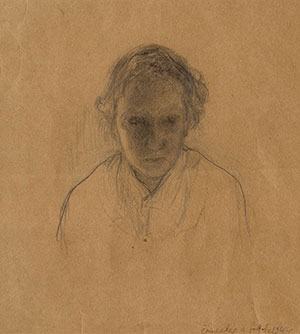
Budapest, 1947
Chalk on paper
50 x 35.2 cm
Gift of the artist's estate
 Born in Budapest. She studied art with private teachers, including Tibor Gallé and Viktor Erdei. In 1940, her works were first displayed in an exhibition sponsored by the Hungarian Jewish Cultural Association [OMIKE]. Between 1942-1943, she studied art at István Örkényi-Strasser’s private school. Following the German occupation of Hungary in June 1944, Gedő was interned in Yellow-Star houses and, in November 1944, she was deported to the ghetto. When she was summoned for transport eastward, one of the elderly in the community reported in her place. Thus she managed to evade the transports, and found refuge in the ghetto. With the liberation of Budapest on January 18, 1945 by the Red Army, Gedő came out of hiding, and began to study at the Hungarian Academy of Fine Arts. After six months, she was compelled to leave the academy, and studied in the evenings with the Hungarian Bauhaus artist Gyula Pap. In 1946, she married Endre Bíró, a biochemist. The couple had two sons. After a long hiatus from art, in 1968 Gedő resumed painting. In 1969, she went to Paris, where she lived for a year. Her works were displayed in numerous exhibitions in Paris and Budapest.
Born in Budapest. She studied art with private teachers, including Tibor Gallé and Viktor Erdei. In 1940, her works were first displayed in an exhibition sponsored by the Hungarian Jewish Cultural Association [OMIKE]. Between 1942-1943, she studied art at István Örkényi-Strasser’s private school. Following the German occupation of Hungary in June 1944, Gedő was interned in Yellow-Star houses and, in November 1944, she was deported to the ghetto. When she was summoned for transport eastward, one of the elderly in the community reported in her place. Thus she managed to evade the transports, and found refuge in the ghetto. With the liberation of Budapest on January 18, 1945 by the Red Army, Gedő came out of hiding, and began to study at the Hungarian Academy of Fine Arts. After six months, she was compelled to leave the academy, and studied in the evenings with the Hungarian Bauhaus artist Gyula Pap. In 1946, she married Endre Bíró, a biochemist. The couple had two sons. After a long hiatus from art, in 1968 Gedő resumed painting. In 1969, she went to Paris, where she lived for a year. Her works were displayed in numerous exhibitions in Paris and Budapest.
Shortly after the liberation, twenty-six year old Gedő depicts herself without a head, while focusing on her fragile upper body and hands deformed by pain. The portrait reveals the artist's difficulty in returning to life following her undermined existential state and the disturbing questions about identity.